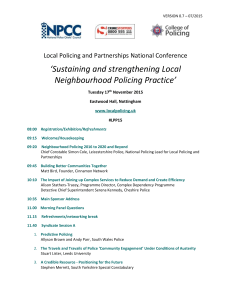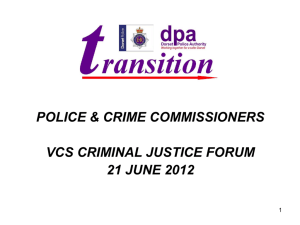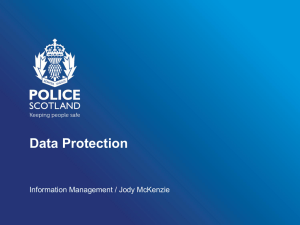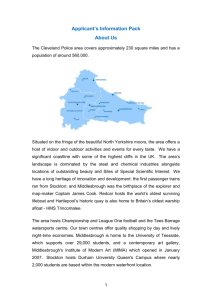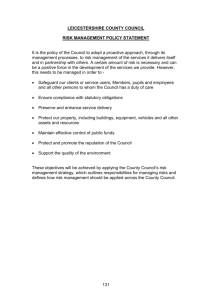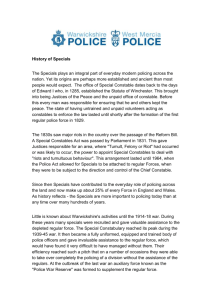Annual Governance Statement - Gloucestershire Constabulary
advertisement
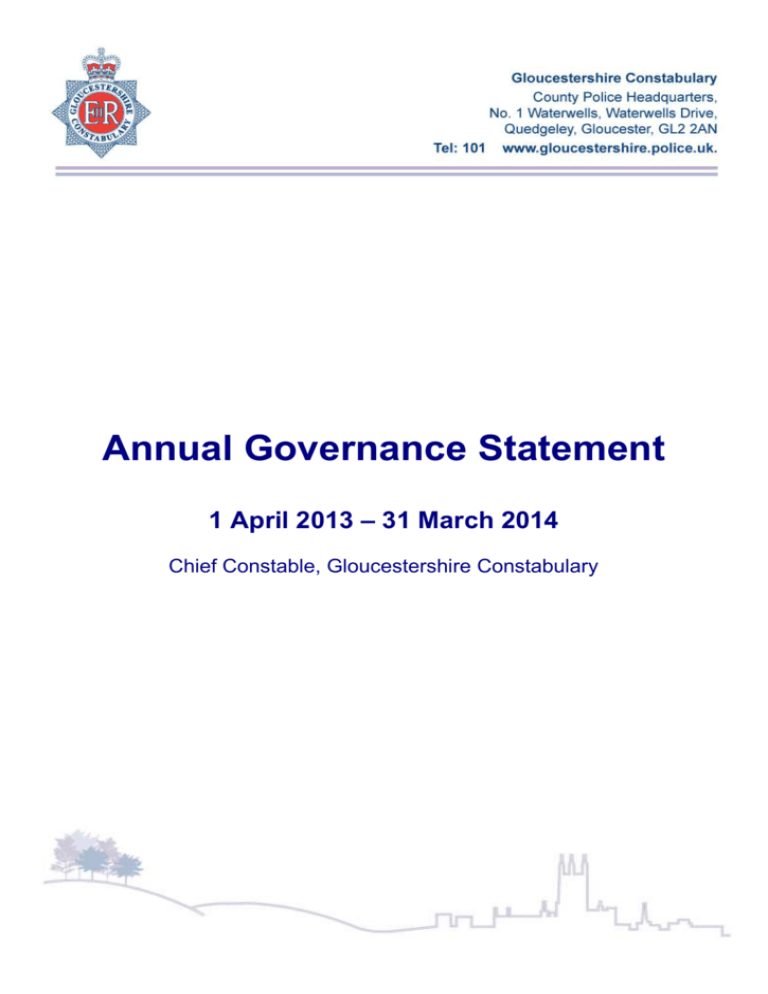
Annual Governance Statement 1 April 2013 – 31 March 2014 Chief Constable, Gloucestershire Constabulary BACKGROUND ........................................................................................................... 3 ANNUAL GOVERNANCE STATEMENT ............................................................................ 3 Scope of Responsibility ....................................................................................... 3 THE PURPOSE OF THE GOVERNANCE FRAMEWORK ...................................................... 4 THE GOVERNANCE FRAMEWORK ................................................................................ 4 The Policing Protocol .......................................................................................... 4 STAFFING CHANGES .................................................................................................. 5 Changes in Chief Officer Group .......................................................................... 5 Changes in Senior Officers ................................................................................. 5 Changes in Executive Staff ................................................................................. 5 ORGANISATIONAL CHANGES....................................................................................... 6 Governance Review ............................................................................................ 6 Organisational Development Review .................................................................. 7 Enabling Services Review ................................................................................... 7 Operating Model.................................................................................................. 7 Second Transfer.................................................................................................. 7 Joint Branding ..................................................................................................... 7 Strategy Review .................................................................................................. 8 DECISION MAKING ..................................................................................................... 9 PERFORMANCE MONITORING ..................................................................................... 9 MEASURING THE QUALITY OF SERVICE FOR USERS .................................................... 10 RISK MANAGEMENT PROCESSES .............................................................................. 12 INTERNAL & EXTERNAL AUDIT AND THE AUDIT COMMITTEE ......................................... 13 CODES OF CONDUCT AND THE STANDARDS OF BEHAVIOUR ........................................ 14 COMMUNICATION CHANNELS .................................................................................... 15 FINANCIAL MANAGEMENT AND CONTROL ................................................................... 15 The Role of the Chief Financial Officers ............................................................ 15 LEGAL COMPLIANCE ................................................................................................ 16 INVESTIGATING COMPLAINTS .................................................................................... 17 CONDITIONS OF EMPLOYMENT AND REMUNERATION .................................................. 18 REVIEW OF EFFECTIVENESS..................................................................................... 19 SIGNIFICANT GOVERNANCE ISSUES .......................................................................... 20 SIGNATORIES .......................................................................................................... 21 2 Background The Annual Governance Statement is one way in which public sector bodies can assess and demonstrate that they are taking a responsible and informed approach to governance arrangements. Good governance arrangements aim to achieve the highest standards in a measured and proportionate way, and demonstrate that resources are directed in accordance with agreed policy and according to priorities, that there is sound and inclusive decision making and that there is clear accountability for the use of these resources in order to achieve desired outcomes for communities. Both the Chief Constable and the Police and Crime Commissioner (PCC) are subject to the Accounts and Audit (England) Regulations 2011 and as such both have to prepare a set of accounts in accordance with the CIPFA Code of Practice on Local Authority Accounting and are subject to audit. Group accounts must be completed by the PCC for the PCC and the Chief Constable. The Chief Constable must complete individual accounts. Both the Chief Constable and the PCC are required to produce an Annual Governance Statement. Annual Governance Statement Scope of Responsibility The Chief Constable is responsible for ensuring that policing in Gloucestershire is conducted in accordance with the law and proper standards, and that public money is safeguarded, properly accounted for, and used economically, efficiently and effectively. The processes relating to those standards and governance arrangements have been applied across all areas of the organisation, including those operating in the Office of the Police and Crime Commissioner. Therefore, for the purposes of this document reference is made to ‘The Organisation’. There is also a duty under the Local Government Act 1999 to make arrangements to secure continuous improvement in the way in which its functions are exercised, having regard to a combination of economy, efficiency and effectiveness. In discharging this overall responsibility, proper arrangements for the governance of affairs and facilitating the exercise of functions, which included ensuring a sound system for the management of risk have been put in place. The Organisation has approved and adopted a Code of Governance, which incorporates the principles of the CIPFA / SOLACE Framework: Delivering Good Governance in Local Government. This statement explains how the Code has been complied with and how the requirements of regulation 4(2) of the Accounts and Audit Regulations 2003 as amended by the Accounts and Audit England Regulations 2011, regulation 4(3), which requires all relevant bodies to prepare an Annual Governance Statement have been met. 3 The Purpose of the Governance Framework The governance framework consists of the systems and processes, the culture and values by which the organisation is directed and controlled, and the activities through which it engages with its communities. It enables the organisation to monitor the achievement of its strategic objectives and to consider whether those objectives have led to the delivery of appropriate services and value for money. The system of internal control is a significant part of the framework and is designed to manage risk to a reasonable level. It cannot eliminate all risk of failure to achieve policies, aims and objectives; it can therefore only provide reasonable and not absolute assurance of effectiveness. The system of internal control is based on an ongoing process designed to identify and prioritise the risks to the achievement of policies, aims and objectives, to evaluate the likelihood and the potential impact of those risks being realised, and to manage them effectively, efficiently and economically. The governance framework has been in place for the year ended 31st March 2014 and up to the date of approval of the statement of accounts. The Governance Framework The Policing Protocol The Policing Protocol Order 2011 (statutory instrument) came into force on 16th January 2012 and extends to England and Wales. The Protocol sets out how policing governance arrangements between the Chief Constable and the PCC work. It clarifies their roles and responsibilities and those of the Police and Crime Panel by outlining what those bodies are expected to do and how they should work together to fight crime and improve policing. The Chief Constable is accountable in law for the exercise of policing powers and is accountable to the PCC for the delivery of efficient and effective policing and that public money is safeguarded and properly accounted for, and used economically, efficiently and effectively. In discharging this overall responsibility, the Chief Constable is responsible for establishing and maintaining appropriate governance arrangements and risk management processes and ensuring that there is a sound system of internal control which facilitates the effective exercise of these functions. The PCC is required to hold the Chief Constable to account for the exercise of those functions and those of the persons under her direction and control. It therefore follows that the PCC can satisfy himself that there are appropriate mechanisms in place for the maintenance of good governance and that these operated in practice. The content of this document provides some detail on the systems, processes, culture and values throughout both organisations. The content reflects major areas and is not an exhaustive list of all control issues in place. It also reflects some of the major changes that have taken place during the period of this statement. 4 Staffing Changes Changes at the strategic management level of the Organisation implemented during 2013/14 and the period following include: Changes in Chief Officer Group Deputy Chief Constable Hansen was appointed on the 13th May 2013 Assistant Chief Constable Berry was appointed on the 27th June 2013, having previously been Temporary Assistant Chief Constable Assistant Chief Constable Lambert was seconded to international policing duties on the 31st July 2013, having previously been Temporary Deputy Chief Constable Changes in Senior Officers Chief Superintendent Foster-Turner retired on the 1st April 2013 Chief Superintendent Clay retired on the 31st October 2013 Temporary Chief Superintendent Thompson and Superintendent Mantle were appointed Chief Superintendents on the 6th January 2014 Temporary Detective Chief Superintendent Kinsella was appointed Detective Chief Superintendent on the 27th January 2014 Chief Superintendent Thomas was seconded to the Police Superintendents’ Association of England and Wales on the 31st March 2014 David Pedrick-Friend was appointed Chief Officer of the Special Constabulary on the 11th March 2014 Changes in Executive Staff Dr Jane Baker, Executive Manager for Technology and Change, resigned on the 1st January 2014 Dr Hannah Young was appointed as Transformational Programme Lead on the 5th January 2014 Ms Raj Patel, Executive Manager for Community and People, resigned on the 3rd June 2014 Mr Jonathan Healy, was appointed as the Interim Head of I.T on the 3rd June 2014 Changes in OPCC Staff Andy Champness, Chief Executive OPCC, resigned from the 1st April 2014 John Beevor was appointed as interim Chief Executive, OPCC on the 19th February 2014 whilst a permanent appointment is made. 5 Organisational Changes The 2013/14 year saw significant changes to the Organisation’s strategic management team, culminating in the first full year in post for both the Chief Constable and the PCC. Over recent years the Constabulary has undergone significant change through structural reviews that have been developed in order to meet a challenging and reducing financial provision. Therefore, this year has been used by the strategic management team to ensure that the structures are sustainable, existing ICT, Estates and HR strategies have been reviewed and are aligned; and that the governance arrangements in place across both organisations have been reviewed to ensure good governance arrangements and working practices. Findings from the reviews are being taken forward throughout the next financial year, and will be delivered as part of a series of projects known as the new operating model. Details of the reviews are given below. Governance Review The strategic governance review looked at existing board and meeting structures. Its aim was to realign governance arrangements and meeting structures to more closely reflect the changes to be seen with the introduction of the PCC. Appendix A is a diagram of the new structure. The review was based around a stated aim of ensuring joint membership and working practices wherever possible. Four central tiers were developed, with meetings then falling within those areas: Governance and Strategic Direction Strategic Oversight Monitoring and Performance Assurance Business Oversight The design also allows for each organisation to have the same tiered structure for meetings that are individual to them. Principles applying to the joint meetings within the four tiers are that: All decisions are subject to the Corporate Governance Framework, Financial Regulations and Contract Standing Orders Every Board, Meeting, Group and Panel only has authority within its terms of reference Every Board, Meeting, Group and Panel can only approve financial spend within budgets under their control unless otherwise stated No Board, Meeting, Group or Panel can make a decision which is likely to be regarded by the Commissioner as novel, contentious or repercussive except for the Governance Board. Terms of reference, financial limits and membership were also set. Meetings are sequenced and use a standardised reporting template. This approach ensures that business decisions can progress as needed through the board structure with minimal delay. 6 Organisational Development Review The overall aim of the project was to provide recommendations for ways in which service delivery can be provided now and in the future, with an indication of associated cost. The project worked towards achieving affordable service delivery in 2015/16, with implementation taking place throughout 2014/15 and was set against an assumption that there will be a need to achieve a further £10-12m savings by 2016/17. Enabling Services Review Following on from the Organisational Development Review a further jointly commissioned review was undertaken into the functions that operate in support of operational policing, known as the ‘enabling services1’. The review enabled the Organisation to make strategic decisions about the ways in which enabling services are delivered in the future along with the structures that enable these to function effectively and efficiently. The project aim was to deliver a resilient and sustainable way of working that does not require regular redesign of the operating model but provides sufficient flexibility to respond to service and operational requirements now and in the future. Operating Model The two reviews have been amalgamated under a programme of work taking place over the next two years (201415 and 2015/16), with the new structure taking place gradually to coordinate with practical changes. The aim of the programme is to reduce duplication of effort and ‘do’ things once by implementing processes that create the simplest possible route for the public to receive the service they need and avoid unnecessary work for officers and staff. The work is supported by changes to the use of the estate and development of the use mobile technology, to create a more efficient, effective and visible service. Second Transfer Significant work was undertaken during 2013/14 to plan for the Second Transfer date of 1st April 2014. The PCC and Chief Constable agreed proposals to transfer the majority of staff from the employment of the PCC to the Chief Constable. It was also agreed that all assets and contracts would remain in the name of the PCC. In order to facilitate the scheme, the Corporate Governance Framework was reviewed and policies, financial regulations and standing orders were revised. The two CFOs also had to clarify the position regarding corporation tax, VAT and the Local Government Pension scheme for both the PCC and the Chief Constable. Proposals were submitted to the Home Office on the 28th January 2014, and final approval was given to the scheme by the Home Secretary on 28th March 2014. Joint Branding To recognise the partnership approach being taken by the Constabulary and OPCC, a new branding has been developed; it reflects both the colours of the Constabulary and OPCC and demonstrates the rural and urban geography of the county. The joint branding has been applied to corporate literature. 1 Enabling services includes IT, HR, Training, Professional Standards, Vetting and Information Security, Information Assurance, Finance, Procurement, Transport Services, Facilities Management, Support Services and Legal Services. 7 Strategy Review In order to understand the detail of the current Constabulary strategies and resource implications, the PCC commissioned a number of reviews. Supported by the Constabulary’s strategic management team, the reviews were based on a number of factors; to ensure due diligence; to assess whether current plans provided value for money and to meet the manifesto commitment to the communities of Gloucestershire of achieving More Peace, Less Crime And Good Order. Strategies reviewed included: ICT Estates New Custody Build – a review of the contract in relation to the build Technology Strategy Review The PCC has stated that for the police to be effective and reduce crime in a period of austerity we should be innovative, place an emphasis on evidence based policing and focus on crime prevention. He believes that Information and Communication Technologies (ICT) are critical in delivering his commitment to the people of Gloucestershire. To establish if the Chief Constable was maximising the benefit from existing strategies he commissioned the Home Office ICT company to review ICT capabilities and plans, assess if those were fit for purpose and make recommendations as to how those plans could be developed to deliver the innovative approaches he wishes to see. Estate Strategy Review The existing estate strategy was set by the previous Police Authority and included the disposal of a number of police properties. The consultation undertaken by the PCC with the communities of Gloucestershire during the election period, found that many members of the public expressed a wish to see local stations retained. Therefore, the estate review considered how the estate can be best used, and how it will fit in with the new operating model going forward. Custody Review A part of the estate review included an assessment of the project to move to a single custody facility, initiated under the previous Police Authority to replace the existing custody facilities, which are out of date and have been judged as not fit for purpose. The review examined the business case and contract to establish if it was a strategic fit and that it was achieving value for money. The review also included value re-engineering work on the contract to establish where savings could be made. In an open meeting, broadcast by online webcast on the 3rd June 2013, the PCC received details of the business case from the Constabulary and agreed to commit to the contract and a single new build custody facility. 8 Decision Making The Organisation is committed to open and accountable decision-making. To meet this commitment there are procedures to be followed, which include responsibility and procedures for decision-making. These are designed to ensure that all decisions are made in accordance with the following principles: Decisions must be lawful Decisions will respect human rights The desired outcomes should be clear Decisions should be properly reasoned and where appropriate the reasons for rejecting alternatives should be explained Decisions should take account of consultation and advice from officers Significant decisions to be made in public or will be publicly reported wherever appropriate. The revised governance structure is based around a joint decision making approach wherever possible, with attendees from both the Constabulary and the OPCC at several boards, including the Strategic Change Board and the Senior Leaders Board. Where necessary, issues are considered by the Governance Board, which is attended by both the PCC and the Chief Constable, and their officers. Decisions made at this forum are publically available on the PCC’s website. Performance Monitoring Performance monitoring is undertaken through a series of boards and meetings, and culminates with reporting to the Chief Officer Group strategic management team, which includes representation by the OPCC. The series of frameworks meet the following aims: To scrutinise delivery in relation to the Constabulary's stated purpose of reducing harm and inspiring public confidence by monitoring performance on a range of relevant indicators To enable monitoring of external performance frameworks (e.g. HMIC) to identify any areas of potential concern To ensure a balance of service delivery across the full range of police business To make the performance indicators the beginning of a meaningful conversation about performance, rather than make the delivery of targets an end in itself (i.e. meeting the target but missing the point). Strategic performance monitoring is reported to the Performance Operations Meeting, chaired by the Assistant Chief Constable (Operations), and reports contains a broad set of quantitative and qualitative. These reports are also submitted to the OPCC. The Strategic Leaders Board receives financial monitoring reports and the Strategic Change Board receives financial project management reports. Other forums that also monitor performance, operationally, organisationally, and financially, include: The monthly Finance Panel, including the PCC, the Chief Constable, the two CFOs, the Chief Executive and the PCC’s Business Advisor meets to review financial matters. 9 The Chief Officers Group (COG) meets weekly and reviews performance. Senior Leaders’ Board is made up of Senior Officers and Executive Managers and the PCC’s Chief Executive and considers the strategic activities within the Constabulary. The Constabulary has systems in place that are used to co-ordinate and direct Constabulary resources; known as Tasking and Co-ordination. A morning conference call is used to assess any emerging operational requirements. This system means that the Constabulary is able to quickly respond to any performance issues. The morning meetings are then aggregated upwards (See Appendix B): o o o o o Daily Tasking Meeting Weekly Local Tactical meeting Fortnightly Force Tactical meeting Monthly Performance Operations Meeting Quarterly Strategic Priorities Review Board The Risk Review Group monitors the Organisation’s Strategic Risk Register and the high risks on departmental risk registers. As a publicly funded service, the police are subject to inspection and scrutiny by various government agencies and departments. The main agency being; Her Majesty’s Inspectorate of Constabulary (HMIC) who are responsible for carrying out annual inspections of police forces, including assessment, of specific policing areas Every officer and member of staff has personal objectives that link back to the Constabulary Objectives. Achievement of these is monitored via quarterly job chats with supervisors. Measuring the Quality of Service for Users There have been various methods used in order to ensure the best use of resources: Local Policing Survey Every year the Constabulary consults with members of the public using a survey to gather opinions about local policing. The survey is carried out with members of the public who live within the county; are policed by Gloucestershire Constabulary; and who may or may not have had direct contact with the Constabulary. This survey assesses: Perceptions of levels of crime and antisocial behaviour Perceptions of the police, i.e. are they doing a good job and tackling local issues? Whether the public feel they are informed about policing in their area, and Levels of public confidence in Gloucestershire Constabulary Telephone interviews are carried out monthly with a random sample of households (determined by random-digit dialling). Approximately 300 interviews are obtained each month with equal numbers of respondents from each Local Policing Area. This will yield a large enough sample by the end of each year for data to be analysed at Local Policing Area level. 10 User Satisfaction Survey Each month, a sample selection of victims of crime are invited to take part in a user satisfaction survey. This is a survey conducted over the telephone, which asks victims to rate their satisfaction or dissatisfaction with various elements of the service they received. It also invites them to suggest improvements, or to alert the organisation to failures in service. The results are presented in various ways, in order to monitor performance, highlight improvements and provide an early warning system if gaps in satisfaction appear to be emerging. The survey has a national format and range of questions. The data is used by the Home Office and HMIC in order to compare performance with other Forces and to monitor progress. Other Research Forest Consultation As a result of discussions regarding the estate within the Forest of Dean and leading on from the PCC’s manifesto pledge to maintain Coleford Police Station, consultation was carried out with Forest communities throughout the months of June to October 2013. This involved conducting public and staff surveys, a focus group in each of the five Forest communities and an additional focus group with the Youth Forum in Coleford. The findings met all of the requirements of the Terms of Reference; to establish, through engagement what policing in the Forest of Dean might look like in the future, both in terms of physicality and service delivery. Much of the focus of both the public and staff was on the delivery of local, accessible policing services. The results will inform any future decision making about policing in the Forest of Dean and also the ongoing development of the new Operating Model. Automatic Number Plate Recognition (ANPR) Consultation A five year strategy to guide, maintain and expand ANPR was set in January 2011. This included a proposal to close capability gaps by increasing ANPR static coverage into a wider area in Cheltenham. Principal uses for ANPR are: 24/7 monitoring of our roads for suspects and offenders Opportunity for real-time response to priority ‘hits’ ‘Fast track’ action to serious and volume crimes ‘Fast track’ action in response to missing people Cost effective intelligence development Post incident investigative use of to prove or disprove lines of enquiry An alternative to mobile solutions in covert investigations Identification of regional and national movements of serious and organised crime groups The Organisation expressed a wish for consultation to be undertaken with the public and partner agencies to obtain an understanding of the public’s view of ANPR and their wish to expand the network in Cheltenham. 11 Although the proposal for expansion at this stage was for Cheltenham, it was considered sensible to seek the views of people in other parts of Gloucestershire as they may travel to and from Cheltenham. It would also possible to determine the views of potential extension to other parts of the County. Consultation channels included focus groups with members of the public, meetings with partner organisations and letters. This was supported by a media campaign and the use of the PCC’s Neighbourhood Engagement Van, which visited each of the Local Policing Areas. The public were more likely to express support for the expansion if they felt informed about the use of ANPR. This involved the delivery of a formal presentation by subject experts and an opportunity for participants to ask any questions about the technology. This process acted to alleviate concerns, dispel myths and sell the benefits of ANPR. The results provided overall support for the expansion of ANPR technology into Cheltenham and also into the surrounding areas within Gloucestershire. PCC Commissioned Research Budget Consultation In setting his budget and in determining the Council Tax precept, the PCC must obtain the views of the business community. Given the need for the PCC to be accountable and accessible, the consultation was widened so that it not only obtained the views of the business community, but also the views of the public in Gloucestershire, as well as specific groups within the voluntary and charitable sectors and police officers and police staff. The aims and objectives of the communication and consultation were to explain in an understandable way: The financial issues facing the PCC and the Chief Constable and the need for a three year budget. The implications of not increasing the budget or of increasing the budget. The benefits of a responsible and long term approach to budget planning which provides stability. The process was designed to provide information as well as consultation opportunities, so that people felt informed enough to provide their views about the budget setting proposals. There were many stakeholders for this work, including the general public, officers and staff, the business community, voluntary and charitable sector, partner organisations amongst others. A range of engagement and consultation channels were utilised, which included telephone surveys, online surveys, letters to and meetings with specific organisations, focus groups and the use of the PCC’s Neighbourhood Engagement Van, which visited each of the six Local Policing Areas. The results of the consultation played an important part in securing a Council Tax precept increase of 2%. Risk Management Processes Risk Management processes are embedded in the operational and organisational activities of the Constabulary and Authority, including: Strategic Risk Register Processes Health and Safety Assessments Environmental ISO14001 Assessment 12 Insurance Policies Major projects, which use the Prince 2 project management methodology, and the associated risk assessment and management disciplines. Major projects are supported by project and programme boards who receive risk registers and highlight reports throughout the duration of the projects. The primary objective of the risk management process is to manage threats in a way that reduces the likelihood of them occurring and minimises their impact should they materialise. Associated objectives are to: Integrate risk management into planning and performance frameworks Ensure that activities are undertaken in conjunction with sound principles of corporate governance Improve strategic, operational and financial management Prevent or reduce events that could damage reputation and public confidence Improve service delivery and value for money. Risk Management is a process that establishes through identification, analysis and prioritisation the key risk themes that could affect the ability to meet objectives and the development of the Strategic Risk Register. The Strategic Risk Register is developed through the analysis of risks held on the Constabulary’s, the PCCs, and departmental, operational and functional risk registers. The Strategic Risk Register is presented for scrutiny at the joint Audit Committee. As part of the process: There is a Standard Operating Procedure for Risk Management An embedded culture where everyone is aware of the approach to risk and their responsibilities in relation to it Police Officers and Staff are encouraged to raise potential risks that may concern them. Internal & External Audit and the Audit Committee Internal and external audits are undertaken to assess performance and provide recommendations for areas of improvement. The Organisation commissions the services of the Gloucestershire County Council Internal Audit function, and an annual plan is developed to audit a range of business areas and/or functions during the year. Reports produced are subject to scrutiny by the joint Audit Committee, whose function is to advise the PCC and CC according to good governance principles, advise them to adopt appropriate risk management arrangements and, where necessary, make recommendations for improvements. Progress against the implementation of any recommendation is reported to the Audit Committee until such time as all parties are satisfied that they have been met. 13 The Internal Auditors have expressed the following audit opinion for 2013/14: We are satisfied that, based on the internal audit activity undertaken during 2013/14 and management’s actions taken in response to that activity, enhanced by the work of other external review agencies, sufficient evidence is available to allow us to draw a reasonable conclusion as to the adequacy and effectiveness of the overall internal control environment for the Police and Crime Commissioner and the Chief Constable. In our opinion, for the 12 months ended 31st March 2014, each organisation has maintained a satisfactory overall control environment, to enable the achievement of the key outcomes and objectives. Grant Thornton are the Chief Constable’s independent external auditors. Their work programme is set in accordance with the Code of Audit Practice issued by the Audit Commission and includes nationally prescribed and locally determined work. The Code requires the external auditor to issue conclusions on whether the PCC and the Chief Constable have each put in place proper arrangements for securing economy, efficiency and effectiveness in their use of resources and to give an opinion on the accounts of the PCC and the Chief Constable. Codes of Conduct and the Standards of Behaviour There are a variety of methods used to establish expectations in relation to conduct and standards of behaviour. Some of the main ones are outlined below: Policies and procedures provide a framework that sets out expectations and working practices for the conduct and behaviour of all officers and staff. The Police (Conduct) Regulations 2004 (as amended) reinforce the requirement for compliance with Constabulary policies and the law The Independent Police Complaints Commission ensure that complaints against the police are dealt with effectively and that statutory guidance is followed in the handling of complaints against both Police Officers and Police Staff The Professional Standards Department and the Anti-Corruption Unit undertake investigations in relation to complaints made by members of the public and internal misconduct matters The local Disciplinary Procedures for Support Staff details arrangements for Police Staff The Constabulary has a clear set of Values Each member of staff has been issued with the Staff Code of Conduct Staff holding accreditation to professional bodies are subject to the codes of conduct associated with those bodies The Code of Ethics for the Police Service was published by the College of Policing on 24th April 2014, as part of its Integrity Programme. During 2013/14 the organisation started a programme to ensure that everyone is aware of the Code of Ethics and how they can play their part in implementing the Code. 14 Communication Channels Policies and procedures are on the Organisation’s intranet. Weekly publications of Constabulary Bulletins include articles on policy implementation and policy guidance and describe how compliance will be monitored Operational plans and orders include sections on policy compliance The Corporate Communications Department enhance internal communication channels, including web forums and additional newsletters The Chief Constable and Chief Officers have undertaken a series of briefings to staff throughout the organisation on their expectations and standards of behaviour The Senior Leaders Forum, held monthly with all senior managers in the organisation is used by the Chief Constable, the PCC and Chief Officers to disseminate key messages. The expectation is that managers will brief their staff following the meeting. Presentations given are available to all staff on the intranet Financial Management and Control Financial control has been maintained and operated in respect of the resources under the Chief Constable’s control. The system of internal financial control provides reasonable assurance that assets are safeguarded, that transactions are authorised and properly recorded, and that material errors or irregularities are either prevented or should be detected within a timely period. The Role of the Chief Financial Officers The Home Office ‘Financial Management Code of Practice for the Police Service of England and Wales’ (FMCP) outlines the responsibilities of both Chief Finance Officer and emphasises the importance of effective co-operative and constructive relationships between the CFOs of the PCC and the Chief Constable. In March 2014, CIPFA issued a statement on the Role of the Chief Finance Officer (CFO) of the Police and Crime Commissioner and the Chief Finance Officer of the Chief Constable, that sets out how the requirements of legislation and professional standards should be fulfilled by the CFO in carrying out their role. The Statement sets out five principles that define the core activities and behaviours that belong to the role of the CFO and the organisational arrangements needed to support them. These five principles are: 1. The Chief Finance Officer of the PCC and of the Chief Constable is a key member of the Leadership Team helping it to develop and implement strategy and to resource and deliver the PCC’s strategic objectives sustainably and in the public interest. 2. The Chief Finance Officer must be actively involved in, and able to bring influence to bear on, all material business decisions (subject to the operational responsibilities of the Chief Constable) to ensure immediate and longer term implications, opportunities and risks are fully considered, and align with the overall financial strategy. 3. The Chief Finance Officer must lead and encourage the promotion and delivery of good financial management so that public money is safeguarded at all times and used appropriately, economically, efficiently and effectively. 15 4. The Chief Finance Officer must lead and direct a finance function that is resourced to be fit for purpose. 5. The Chief Finance Officer must be professionally qualified and suitably experienced. The Organisation’s financial management arrangements conform with the statement. Financial Control The system of internal financial control is based upon a framework of regular reviews of management information, financial regulations, administrative procedures (including segregation of duties), management supervision and a structure of delegation and accountability. In particular, the financial control system involves: Comprehensive budgeting systems Regular reviews of periodic and annual financial reports which indicate financial performance against the forecasts; A structured business planning process Clearly defined revenue and capital expenditure guidelines The system of internal financial control is subject to regular review by the internal audit service. Gloucestershire County Council’s Internal Audit Unit provides this service. The Unit operates under the Accounts and Audit Regulations, which require: The maintenance of an adequate and effective system of internal audit of accounting records and control systems Full assistance in the provision of documents, records, information and explanation to enable the proper fulfilment of those audit responsibilities. The work of the Unit is guided by and reflects professional best practice, in particular the CIPFA Code of Practice on Local Government Internal Audit and locally by the policies, procedures, rules and regulations. During 2013/14 internal audit reports were prepared on Treasury Management (substantial assurance) and Procurement (substantial assurance). Whenever possible controls are built into systems (e.g. procurement regulations are embedded into the e-procurement system). This is in turn backed up with formal procedural notes and desk instructions for key processes and controls. Legal Compliance In house legal advice is used to ensure that the Organisation acts legally in discharging its functions and also provides advice on new legal developments. The Head of the Legal Services Department (the Force Solicitor) reports directly to the Deputy Chief Constable and is a member of various decision making forums. The Force Solicitor also acts as the legal representative where required. All procurements with a contract value over £40,000 are undertaken by the regional procurement unit (the South West Police Procurement Department – SWPPD) on behalf of the PCC. This ensures that all contractual matters are complied with including European Union procurement requirements relating to the issue of contracts and the provision of goods, supplies or services. Assurance in relation to personnel and employment legislation is provided by the People Services Unit. 16 Policy Compliance Policies may be locally defined or nationally defined and locally adopted. Policies are intended to promote equality, eliminate unlawful discrimination and actively promote good relationships regardless of age, disability, gender, race or ethnicity, religion and belief, and sexual orientation. Policies are impact assessed using an Equalities Impact Assessment. Building equality considerations into the policy-making process ensures the identification of any actual or potential inequalities and reduces them as much as possible, by applying the policy differently or looking for alternatives. Dissemination The dissemination and reinforcement of these policies is undertaken in various ways, including: Internal, external and national training courses. Professionally qualified staff provide advice on policy interpretation and highlight areas of change. The Constabulary Legal Services Department provides guidance on policy interpretation and legality. The supervisory structures and processes within the Constabulary provide support for dissemination and interpretation of Constabulary policies Ensuring Compliance Internal inspections and audits have, within their programme, an examination of compliance with policies The Professional Standards Department and the Anti-Corruption Unit undertake investigations in relation to complaints made or identified misconduct matters, including breaches of policy by staff. The Organisation operates an anonymous online reporting system for whistleblowing. Investigating Complaints The Professional Standards Department and the Anti-Corruption Unit undertakes investigations in relation to complaints made by members of the public, or identified misconduct matters, including breaches of policy by staff. They also undertake investigations into any Direction and Control Complaints in respect of organisational or operational decisions. Policies are in place for whistle-blowing, and are supported by the Fraud and Anti-Corruption Policy. The policy is supported with internal procedures for Fraud, Corruption, Unethical Behaviour and Wrongdoing. Members of the public can make complaints to the Chief Finance Officers regarding the proper administration of financial affairs. If the CFO considers there is a need to report this they are required by legislation to make a report and send a copy to the PCC, the Chief Constable and the external auditor. The CFO should also inform members of the Audit Committee, the Police and Crime Panel and the internal auditor. 17 Conditions of Employment and Remuneration All staff have conditions of employment and remuneration which are commensurate with their roles and responsibilities. The pay and terms of conditions of all UK Police Officers are negotiated through the Police Negotiating Board (PNB). Local Government Employers provide the Employers' Side of the PNB while the Staff Side is represented by the Police Federation, the Superintendents' Association and the Chief Police Officers' Staff Association. The PNB exists to negotiate agreements, which it recommends to the Home Secretary. If accepted by the Home Secretary, they are placed within a draft statutory instrument (Police Regulations), and put to Parliament for approval. PNB agreements are legally binding once placed in Regulations. The Police Staff Council (PSC) negotiates national agreements on pay and conditions of service for police staff, including Police Community Support Officers in England and Wales, excluding the Metropolitan Police. In some instances pay and conditions may be subject to local variation, which will be undertaken in consultation with recognised trade unions. Information is communicated by both employer and joint circulars. Joint circulars are issued by the PSC. Employer circulars are issued by the employers. Partnership Governance In developing its significant partnerships, the Organisation has ensured that it has in place a framework that enables its risks to be mitigated to an acceptable level. Statutory partnerships are subject to either contractual agreements or are governed by legislation. Significant partnerships are subject to initial project planning and are supported by contractual agreement for example: Partnership with National Police Air Service (NPAS) Public Protection Bureau with eight partnership agencies Collaboration between the South West and North West Force on the Forensic Science Service Consortium Contract Tri Force Firearms facility The Sexual Assault Referral Centre with the Gloucestershire Care Services NHS Trust Tri-Service arrangements with the Fire and Ambulance Services Regional Serious and Organised Crime capabilities (known as Zephyr), which contains Intelligence, Asset Recovery and Crime teams Tri Force Specialist Operations of Road Policing, Firearms and Dogs Units, and Collision Investigation. 18 Review of Effectiveness The Organisation has responsibility for conducting, at least annually, a review of the effectiveness of the governance framework including the system of internal control. The review of effectiveness is informed by the work of senior officers and staff who have responsibility for the development and maintenance of the governance environment, the annual report from the head of internal audit, and by comments made by the external auditors and other review agencies and inspectorates. In compiling this statement the current governance arrangements have been reviewed and are regarded as fit for purpose in accordance with the governance framework. The areas already addressed and those to be specifically addressed with new actions planned are outlined below. 19 Significant Governance Issues Issues: Update on the Medium Term Financial Strategy The organisation has already identified significant annual savings – over £26 million in the five years from 2010/11 to 2014/15. The annual budget for 2014/15 is £107 million. These savings have been planned and risk assessed to avoid a significant effect on frontline policing. In November 2013 the Chancellor announced that financial austerity will continue until at least 2017/18 and that further cuts will be made to government funding. No figures have been provided for grant reductions from 2015/16 onwards and no indications have been given regarding pay restraint after 2016. The PCC has committed to freezing Council Tax for both 2015/16 and 2016/17. It is unlikely that long term planning assumptions will be provided until after the next General Election in May 2015. The two CFOs have made assumptions based upon the last few years and have calculated a number of scenarios. These show that further annual savings will be required, between £10m and £14m, up to 2017/18. These scenarios are being used by the Transformation team in developing the new Operating Model and further business improvement work. This level of savings will have a significant effect upon the organisation and will require further reductions in the numbers of police officers and staff. Stage 2 Transfer Included within the Annual Governance Statement for 2013/14 was the potential impact of changes introduced as a part of The Police and Social Responsibility Act 2011in relation to the Stage 2 transfer, which refers to the movement of certain staff, property, rights and liabilities from the PCC to the Chief Constable. The Home Office indicated that the Stage 2 transfer must be implemented no later than the 1st April 2014, and included a requirement for proposals to be presented by all PCCs and Chief Constables ahead of that time, in order that they could be considered and approved to meet this deadline. The proposals were submitted and were ratified by the Home Secretary. Therefore, this aspect of the significant governance issue is now considered closed. Also included within that entry was the potential impact relating to the national resolution of some of the financial, legislative, social, organisational and cultural regulations previously in place in respect of Police Authorities. The Home Office subsequently nationally resolved the issues and therefore this aspect of the significant governance issue is also now considered closed. 20 Signatories Deputy Chief Constable 19th September 2014 Peter Skelton Chief Finance Officer, Police 19th September 2014 21 Appendix A Meeting Governance Structure 1 Appendix B Tasking & Co-Ordinating Process 1

